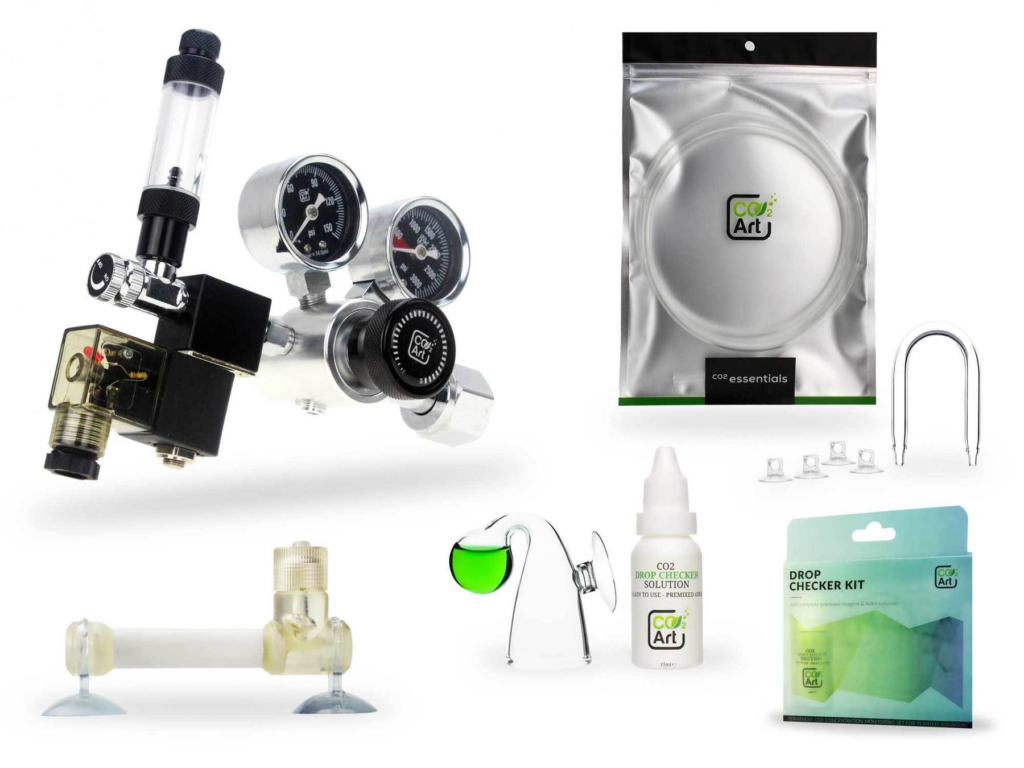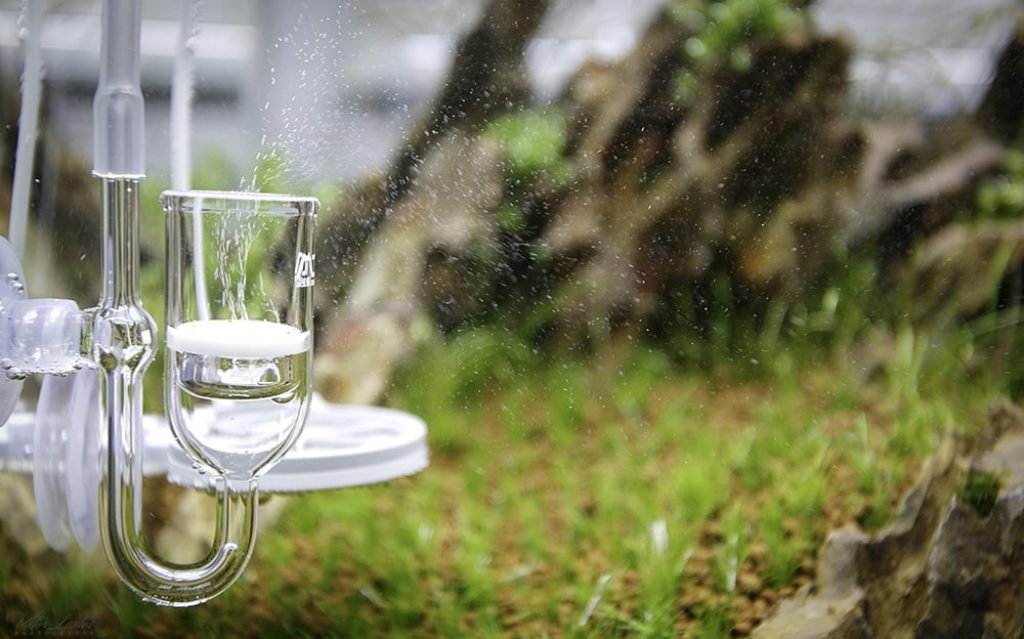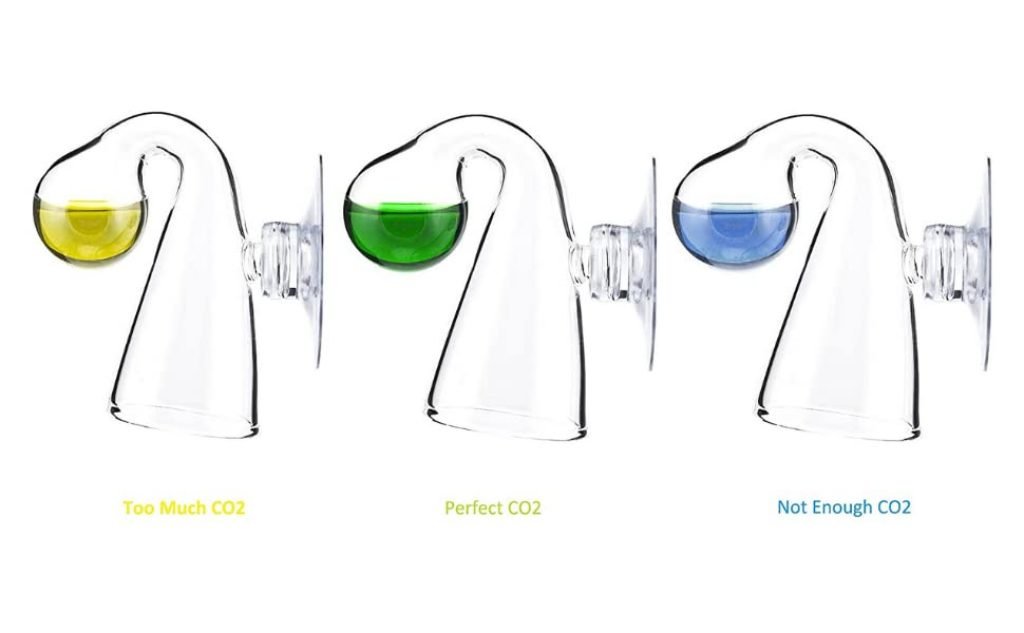
If you do not know what you are doing, or getting yourself into, you can end up with big problems including killing our fish, hence I decided to write this article. I hope this article will help people new to using pressurized Co2 or DIY to do their research before venturing out into the land of using Co2 in your planted aquarium.
What equipment will I need to run a pressurized Co2 system?
- A pressurized container, is usually a fire extinguisher, you can even in some cases use a paintballs canister or a Soda Stream bottle. But for these, you would need a special converter, so your regulators can connect to them.
- A regulator, a solenoid, and a needle valve. As the names state, the regulator regulates the amount of Co2 that enters your aquarium. The needle valve gives you finer control over your Co2. And the solenoid converts electrical energy into mechanical work, basically acting as an on/off switch to stop and start the flow of Co2 using electrical current.
- The Co2 diffuser, allows an effective method for Co2 to enter the aquarium. The Co2 is pushed through a porous medium that breaks down the gas into a fine mist of bubbles. These bubbles are then more easily absorbed by your aquarium water. The longer the Co2 bubbles are in contact with your aquarium the bigger the chance it gets absorbed into the water.
- The Co2 drop checker, as Co2 gas is absorbed into the indicator solution, it lowers the pH of the KH standard, which in turn changes the color of the pH indicator.
- Co2 bubble counter, allow you to monitor the flow rate of Co2 into your aquarium. Being able to visually monitor the CO2 flow rate helps you determine if you are injecting too much or too little Co2 into your aquarium.
- A non-return valve, which allows oxygen from an air pump or in this case Co2 to flow in only one direction. And is fitted to ensure that the Co2 flows through a pipe in the right direction, where pressure conditions may otherwise cause reversed flow.

How it works, and how the hardware fits together.
Co2 in a pressurized container passes through a regulator, a solenoid, and a needle valve. Co2 is then added to the tank through a CO2 diffuser, which is usually made of ceramic. Co2 is added to an aquarium at a rate of “x” amount of bubbles per second, which is monitored using a CO2 bubble counter.
How does injecting Co2 benefit your aquarium plants?
Biology in school classes taught us that the basic building block of all organisms is Carbon, and that plants need Co2 and light so they can photosynthesize. During photosynthesis, aquarium plants take in carbon dioxide (Co2) from the aquarium water. Within the plant cell, the water is oxidized, meaning it loses electrons, while the carbon dioxide is reduced, meaning it gains electrons. This transforms the Co2 into oxygen and the carbon dioxide into glucose, the glucose is then used as food for the plants to grow.
When do I need Co2 in my aquarium?
Whilst no two aquariums are the same, I’m going to say that not every planted aquarium needs Co2. You need to do your research and determine for yourself if and when you want to add CO2 to your aquarium. But aquariums and plants can be divided into three categories: Low-tech planted tanks, do not need CO2 addition. Low-tech tanks are classified as tanks with low light, easy-to-grow plants, usually, an inert substrate, and a simple fertilization strategy be it root tabs or liquid fertilizer. Medium-tech planted tanks do not need pressurized CO2 addition.
Medium tech tanks are classified as tanks with better lighting, some more difficult-to-grow plants, typically a nutrient-rich substrate, and a more complex fertilization strategy. Typically, this tank will get Carbon in a liquid form, often through products like Scape Carbon or Seachem Excell. High-tech planted tanks require Co2. These tanks typically have very difficult-to-grow plants, high lighting, a nutrient-rich substrate, and a highly complex fertilization regime.

How does injecting Co2 into your aquarium affect your water parameters?
We’ve all at some point in the hobby heard the terms “general hardness” (aka gH), “carbonate hardness” (aka kH), and the more commonly referred to term “pH”. Right off the bat, I am going to state right now that if you do not have a fairly accurate way of testing these three within your tank. Then please do not attempt to inject Co2 into your aquarium, as you need to have a method of monitoring these. Right, let’s start with gH. gH represents the general hardness of your water. This hardness is determined by the amount of Calcium and Magnesium that is in your water. In order to get the best plant growth, you need to have a gH of about 4 degrees. Cape Town water is known to have zero hardness, and planted tanks need to have a gH additive added to their tanks.
In Johannesburg, if you test your gH, you will find the result rather high, (between 6-8 degrees). Now let’s look at the pH. pH (Potential Hydrogen) is a measure of the acidity or basicity of an aqueous solution. If the reading is below 7.0, the solution is considered acidic, and if it goes above 7.0, the solution is considered Alkaline. Carbonate Hardness is a measurement of the water’s Carbonate content. Within the context of fishkeeping, the Carbonate hardness acts as a buffer to prevent your aquarium’s pH from swinging. It is commonly known that pH has a tendency to “swing” within aquariums. It is also commonly known that having a stable pH is more important than having the “correct” pH within your aquarium, as the swinging of pH is more detrimental to the health of the fish. The higher the kH, the less the pH will swing, as the kH acts as a buffer to prevent this swinging.

What are pH swings? And should I be concerned?
When Co2 is added to aquarium water, this will naturally alter the pH level of the aquarium water and make it more acidic. Which will then cause your pH to swing to the acidic side of the scale. At night, when the CO2 is switched off, the pH will slowly swing back. When your water’s kH is too low, you run the risk of experiencing what is commonly termed a pH crash in the fishkeeping hobby. This is when the pH drops a lot, and very quickly. This will kill off all your fish overnight.
Is there a way I can stop my pH from swimming too quickly?
Yes, there is! Adding aragonite or crushed coral is a common practice when injecting Co2, however, this needs to be seen as insurance against the pH drop, but does not stop that pH swing entirely. When you use Co2 injection, you need dissolved carbonate to serve as a buffer. The crushed coral or aragonite you have added is your insurance policy against a pH crash.
How much Co2 do I need to add to my aquarium?
This is where you need to start experimenting yourself. There is no set injection rate here. You may get perfect growth from 1bps (Bubbles Per Second), but I may need 3bps. This is where you need to monitor your aquarium (in regard to pH and kH) to determine what rate you are to inject Co2. If you inject too much, you acidify your water and can potentially kill all your fish. If you inject too little, you land up with algae blooms that are benefiting from the complete fluctuation of Co2 levels in your aquarium.
What about DIY Co2?
Yes, I did not forget about DIY Co2, but that is a completely new article on its own. But for more details on how to build and run a DIY Co2, you can watch the following video below:
In closing…
There’s one thing that I have learned while injecting Co2 is not only finding the balance between nutrients, light, and Co2 but also maintaining the balance between Calcium vs. Magnesium (gH), your kH and your pH. Hopefully, this guide will help you venture










